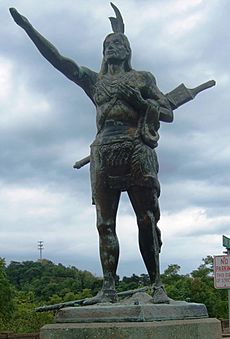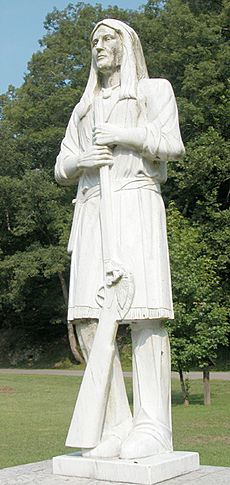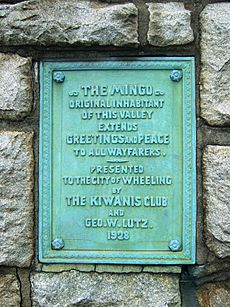Mingo facts for kids
The Mingo people are a group of Native Americans. They are part of the Iroquoian family. Most Mingo people were originally Seneca and Cayuga tribes. They moved west from New York to the Ohio Country in the mid-1700s. Some Susquehannock survivors also joined them and became part of the group.
Early Anglo-Americans called these migrants "Mingos." This name came from an Eastern Algonquian word, mingwe. It was a general name for Iroquoian-speaking groups. The Mingo have also been known as "Ohio Iroquois" or "Ohio Seneca."
In the early 1830s, the United States government forced most Mingo people to move. This was part of the Indian Removal program. They had to leave Ohio and go to Indian Territory. Later, around 1900, they lost control of their shared lands. The government divided the land among individual families. This was an effort to make Native Americans live more like European-Americans. It was also linked to the Dawes Act and preparing for Oklahoma to become a state.
In the 1930s, Mingo descendants formed a new tribe. They created their own government. In 1937, the U.S. government officially recognized them. They are now known as the Seneca–Cayuga Tribe of Oklahoma.
Contents
Mingo History and Origins

The name "Mingo" comes from the Delaware word mingwe. This word means "stealthy" or "cunning." In the 1600s, the terms Minqua or Minquaa were used. They referred to both the five nations of the Iroquois League and the Susquehannock people. Both groups spoke Iroquoian languages.
The Mingo people sometimes had a difficult reputation. They were even called "Blue Mingo" or "Black Mingo." This was because of some of their actions. The people who became known as Mingo moved to the Ohio Country in the mid-1700s. This was part of a larger movement of Native American tribes. They were moving away from European settlements. The Ohio region had few people living there. However, the Iroquois League used it as a hunting ground. The "Mingo dialect" spoken in the Ohio valley was very similar to the Seneca language.
Life in the Ohio Country
After the French and Indian War (1754-1763), many Cayuga people also moved to Ohio. The British government gave them a special area along the Sandusky River. Shawnee people from Ohio joined them there. Other Mingo groups also came together. Their villages became a mix of different tribes. These included Iroquoian-speaking Seneca, Wyandot, and Susquehannock. There were also Algonquian-speaking Shawnee and Delaware people.
The Iroquois Confederacy had claimed hunting rights over the Ohio River Valley. This had been true since the late 1600s. However, the tribes living there started to act more independently.
Mingo Leaders and Wars
In 1763, Pontiac's Rebellion began. This happened at the end of the French and Indian War. Many Mingo joined other tribes in this fight. They tried to push the British out of the Ohio Country. At that time, most Iroquois nations in New York were allies of the British. The Mingo-Seneca Chief Guyasuta (born around 1725, died around 1794) was one of the leaders in Pontiac's War.
Another well-known Mingo leader was Chief Logan (born around 1723, died 1780). He had good relationships with the white settlers nearby. He was not a war chief, but a village leader. In 1774, tensions grew between white settlers and Native Americans. A group of white outlaws sadly murdered Logan's family. Other chiefs advised him to stay calm. But they also understood his right to get revenge. Logan then led a series of attacks with about a dozen followers. Not all of them were Mingo.
Logan did not take part in Lord Dunmore's War. This war happened because of the rising tensions. He was probably not at the main battle, the Battle of Point Pleasant. Instead of joining the peace talks, he shared his feelings in "Logan's Lament." His speech was printed and shared widely. It is one of the most famous examples of Native American speeches.
Forced Relocation and New Beginnings
By 1830, the Mingo people were doing well in western Ohio. They had improved their farms. They also had schools and other community groups. But in that same year, the U.S. government passed the Indian Removal Act. The government pressured the Mingo to sell their lands. They were forced to move to Kansas in 1832. In Kansas, the Mingo joined other Seneca and Cayuga groups. The tribes shared the Neosho Reservation.
In 1869, after the American Civil War, the U.S. government again pushed for Native American removal. These tribes had to move from Kansas to Indian Territory. This area is now part of Oklahoma. The three tribes moved to what is now Ottawa County, Oklahoma. In 1881, a group of Cayuga from Canada joined the Seneca in Indian Territory.
In 1902, Oklahoma was about to become a state. At that time, 372 members of the combined tribe received individual land plots. This was part of a federal program. It aimed to end shared tribal land ownership. This helped Oklahoma become a state. It also encouraged Native Americans to adopt European-American ways of life.
In 1937, after the Oklahoma Indian Welfare Act, the tribes reorganized. They wanted to restart their own government. They called themselves the Seneca-Cayuga Tribe of Oklahoma. The federal government officially recognized them. Today, the tribe has over 5,000 members. They still keep their cultural and religious connections to the Six Nations of the Iroquois. Most of these nations are based in Canada. Some also have reservations in New York State.
See also
 In Spanish: Mingo para niños
In Spanish: Mingo para niños



